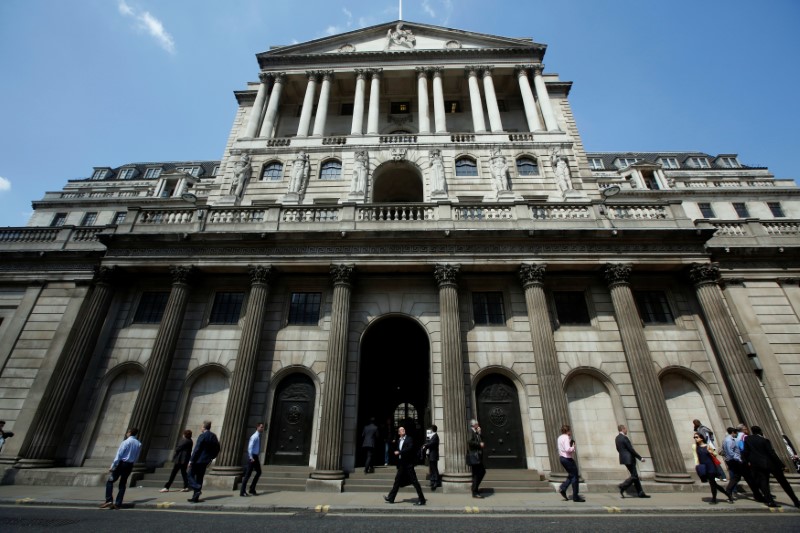 © Reuters. Pedestrians walk past the Bank of England in the City of London
© Reuters. Pedestrians walk past the Bank of England in the City of LondonBy David Milliken and William Schomberg
LONDON (Reuters) – The Bank of England held interest rates on Thursday and said weak growth during a snowy start to 2018 was likely to be only temporary, but it wanted to see a pick-up in the economy in the next few months before raising borrowing costs.
In sharp contrast to widespread expectations just a few weeks ago that it would raise rates, the BoE said its nine rate-setters voted 7-2 to keep them at 0.5 percent.
That was in line with forecasts in a Reuters poll of economists.
Investors responded to the announcement by slightly pushing back their expectations of when the BoE was likely to raise rates for only the second time since the global financial crisis.
Sterling fell to a day’s low of $1.352, reversing earlier gains, and the yield on two-year British government bonds, which are sensitive to monetary policy expectations, fell modestly.
“Rate-setters have kicked the interest rate can down the road once more,” Tom Stevenson, investment director for Personal Investing at Fidelity International said.
Britain’s economy grew more slowly than most of its peers last year after a Brexit-driven jump in inflation hit consumer spending power and some businesses delayed long-term investment.
Growth slowed even more sharply in the first quarter of 2018 due to a mix of unusually snowy weather and headwinds from Britain’s impending exit from the European Union. Surveys have suggested little rebound last month.
The BoE on Thursday cut its forecasts for inflation and for growth, especially in 2018, reflecting the weak first-quarter figures which the central bank said would probably be revised up.
For now, most policymakers wanted to wait to be sure that the weakness passes quickly.
“The recent weakness in data for the first quarter had been consistent with a temporary soft patch, with few implications for … the outlook for the UK economy,” the majority of BoE Monetary Policy Committee members said.
“There was value in seeing how the data unfolded over the coming months, to discern whether the softness in Q1 might persist,” they said.
This potentially leaves the door open for a rate rise in August, the next time the BoE updates its economic forecasts.
INFLATION FALLING ON STERLING EFFECT
Policymakers Ian McCafferty and Michael Saunders, who again voted for a rate rise, agreed the weak growth so far this year reflected “temporary or erratic factors”, but said delaying a rate hike risked more abrupt tightening later on.
BoE Governor Mark Carney suggested in April that the central bank might not raise rates in May because of the mixed economic data, causing a sharp reversal in bets on a May hike.
The central bank said on Thursday that inflation had fallen faster than it expected. But this was due to a faster fading of the impact of the plunge in sterling on the price of imports, and that domestic inflation pressures continued to rise.
Inflation was seen dropping to 2.1 percent in a year’s time, and returning to target a year later – sooner than previously thought – but only if interest rates rose by 25 basis points about three times over the next three years, as markets expect.
The BoE said it expected Britain’s economy would grow by 1.4 percent this year, down from the 1.8 percent rate it predicted in February, which was a bit above what most economists thought likely at the time.
The lower 2018 growth prediction reflected the early weakness.
But slowing consumer lending and a sluggish housing market created greater-than-usual uncertainty about consumer demand, the BoE said.
For 2019 and 2020, it predicted GDP growth would pick up to 1.7 percent, down from 1.8 percent in its February forecasts.
CARNEY’S SIGNALS
The BoE thinks that unless interest rates rise, even modest economic growth of about 1.5 percent a year risks stoking excess inflation, due to Britain’s long-standing weak productivity growth and reduced immigration as a result of Brexit.
Wage growth was forecast to pick up slightly less strongly this year than had been forecast before.
Inflation has fallen after reaching its highest in more than five years in late 2017, but at 2.5 percent it is still well above the BoE’s 2 percent target.
Since he joined the BoE in 2013, Carney has signaled several times that the time was nearing for rates to rise from the historic low of 0.5 percent reached during the 2008-09 financial crisis, only for economic data to surprise him.
In November, the BoE raised rates for the first time in over a decade, reversing a cut made shortly after the Brexit vote.
In February, Carney said rates might need to rise somewhat faster than markets had expected.
A few days before Thursday’s announcement, economists polled by Reuters on average expected rates to rise in August, though a number think the BoE may have missed the boat if growth continues to be lackluster in the run-up to Brexit.
Carney was due to give a news conference to explain the Bank’s latest thinking at 1130 GMT.
(editing by John Stonestreet)
Source: Investing.com



























